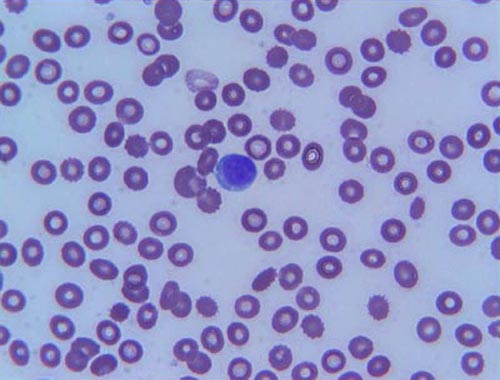Leukopenia, Neutropenia

Published: 18 Jun 2025
ICD9: 288.59 ICD10: D72.818 ICD11: 4B00.00
Leukopenia and neutropenia are both conditions related to a deficiency of white blood cells in the blood, specifically affecting the immune system.
They are often used interchangeably, but there's a subtle difference.
Here's a breakdown:
![]() Leukopenia: This is a general term for a low white blood cell (WBC) count. WBCs are crucial for fighting infection, and having too few makes you more vulnerable to illness. The normal range for a WBC count is typically between 4,500 and 11,000 WBCs per microliter of blood. A count below 4,500 is usually considered leukopenia.
Leukopenia: This is a general term for a low white blood cell (WBC) count. WBCs are crucial for fighting infection, and having too few makes you more vulnerable to illness. The normal range for a WBC count is typically between 4,500 and 11,000 WBCs per microliter of blood. A count below 4,500 is usually considered leukopenia.
![]() Neutropenia: This is a specific type of leukopenia characterized by a low count of neutrophils. Neutrophils are the most abundant type of WBC and are particularly important for fighting bacterial infections. Neutropenia is diagnosed when the absolute neutrophil count (ANC) falls below 1,500 cells per microliter of blood.
Neutropenia: This is a specific type of leukopenia characterized by a low count of neutrophils. Neutrophils are the most abundant type of WBC and are particularly important for fighting bacterial infections. Neutropenia is diagnosed when the absolute neutrophil count (ANC) falls below 1,500 cells per microliter of blood.
In simpler terms: All neutropenia is leukopenia, but not all leukopenia is neutropenia. You can have a low WBC count (leukopenia) because other types of white blood cells are low, even if the neutrophils are within the normal range. However, if neutrophils are specifically low, you have neutropenia.
Causes:
Both leukopenia and neutropenia can be caused by a variety of factors, including:
![]() Infections: Viral infections (like the flu or HIV), bacterial infections, and parasitic infections.
Infections: Viral infections (like the flu or HIV), bacterial infections, and parasitic infections.
![]() Medications: Chemotherapy drugs, antibiotics, antiviral drugs, and some psychiatric medications.
Medications: Chemotherapy drugs, antibiotics, antiviral drugs, and some psychiatric medications.
![]() Autoimmune disorders: Lupus, rheumatoid arthritis.
Autoimmune disorders: Lupus, rheumatoid arthritis.
![]() Bone marrow disorders: Aplastic anemia, myelodysplastic syndromes, leukemia.
Bone marrow disorders: Aplastic anemia, myelodysplastic syndromes, leukemia.
![]() Nutritional deficiencies: Vitamin B12 or folate deficiency.
Nutritional deficiencies: Vitamin B12 or folate deficiency.
![]() Exposure to toxins: Radiation, benzene.
Exposure to toxins: Radiation, benzene.
![]() Splenomegaly: Enlarged spleen.
Splenomegaly: Enlarged spleen.
![]() Congenital conditions: Some people are born with conditions that cause neutropenia.
Congenital conditions: Some people are born with conditions that cause neutropenia.
![]() Cancer: Some cancers can directly affect the bone marrow.
Cancer: Some cancers can directly affect the bone marrow.
Symptoms:
The symptoms of leukopenia and neutropenia depend on the severity of the condition and the underlying cause. Common symptoms include:
![]() Frequent infections: Especially bacterial infections of the skin, mouth, lungs, or blood.
Frequent infections: Especially bacterial infections of the skin, mouth, lungs, or blood.
![]() Fever: Often the first sign of infection.
Fever: Often the first sign of infection.
![]() Sore throat
Sore throat
![]() Mouth sores
Mouth sores
![]() Fatigue
Fatigue
Diagnosis:
Leukopenia and neutropenia are diagnosed with a complete blood count (CBC). If the CBC shows a low WBC count or a low neutrophil count, further testing may be needed to determine the underlying cause. This could include a bone marrow biopsy.
Treatment:
Treatment depends on the underlying cause and the severity of the condition. Possible treatments include:
![]() Treating the underlying infection: Antibiotics, antivirals, or antifungals.
Treating the underlying infection: Antibiotics, antivirals, or antifungals.
![]() Stopping medications: If a medication is causing the problem.
Stopping medications: If a medication is causing the problem.
![]() Growth factors: Medications that stimulate the bone marrow to produce more WBCs (e.g., G-CSF, granulocyte colony-stimulating factor).
Growth factors: Medications that stimulate the bone marrow to produce more WBCs (e.g., G-CSF, granulocyte colony-stimulating factor).
![]() Bone marrow transplant: In severe cases of bone marrow failure.
Bone marrow transplant: In severe cases of bone marrow failure.
![]() Protective measures: Avoiding crowds, practicing good hygiene, and cooking food thoroughly to prevent infection.
Protective measures: Avoiding crowds, practicing good hygiene, and cooking food thoroughly to prevent infection.
In summary: Leukopenia is a low white blood cell count, and neutropenia is a specific type of leukopenia where neutrophils are low. Both conditions can increase your risk of infection and require evaluation by a healthcare professional to determine the cause and appropriate treatment.